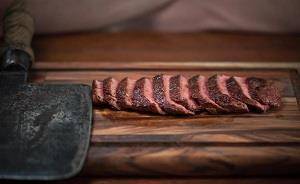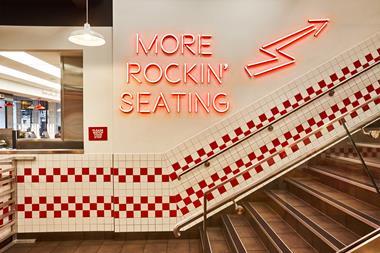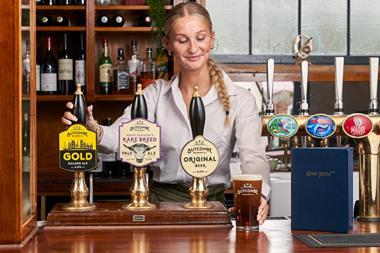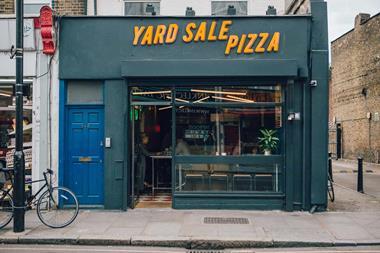For someone who has just opened a new restaurant, Charlie Carroll is pretty laid back. For someone who also has a four-month-old baby at home, he is remarkably so.
OK, the founder of the now four-site-strong Flat Iron Steak business has recently taken a two-week holiday. In fact, he came back on the day the new 75-seat Shoreditch site was handed over, one week before opening. That he has been able to go away at such a critical time says a lot, not only about his confidence in the fledgling affordable quality steak and chips restaurant group, but also the way he operates it and his personality.
“We opened Beak Street [the first permanent site] in November 2012 and in April 2013 I went and spent some time in America. I had the view from the outset that the sites were going to have to be able to operate independently of me from very early on,” he says.
This approach is born from focus and smart working – his background does not even hint that he has ever been work shy.
He admits that the opening of the group’s largest and most expensive venue to date, a 180-seat outlet in Covent Garden, was “brutal” due to the pressure to open it and get it right quickly thanks to the high costs involved compared to his other outlets. But the stresses of running a restaurant group, he says, pale when compared to his early career as a strategy analyst.
A lifelong foodie and determined from a young age that one day he would run his own business, Carroll actually studied natural sciences at Cambridge, specialising in biology. While he loved science, the reality of how repetitive a career in it could be led him down a different path. While at university, he did a few free shifts in the kitchens at Heston Blumenthal’s Fat Duck and Gordon Ramsay’s Royal Hospital Road restaurants, the latter of which he recalls as being a particularly gruelling experience. It put him off the whole restaurant career idea for a few years and convinced him that when he did decide to pursue it again, it would not be from the bottom up. Instead he took a graduate job at Parthenon-EY strategy consultancy. The hours were long and the work exacting, although it gave him invaluable experience related to the industry he is now in, including running the slide rule over Carluccio’s for a potential buyer.
Carroll started formulating an idea based around quality, affordable steak and de-cided he needed a grounding in how a restaurant company operates. A meeting with Mark Selby, co-founder of Wahaca, led to a job as operations advisor at the Mexican market-style restaurant firm, where his analytical skills were put to use to help the chain’s expansion. It also gave him an opportunity to effectively trial a start-up when he was given free rein to launch a takeaway outlet operating from a van, initially serving the Canary Wharf area.
“It was a project in miniature. It gave me the chance to come up with the offer and think about every aspect of how it would operate, all with someone else’s money and loads of support,” he recalls.
Carroll then toyed with the idea of getting some general manager experience before launching on his own, but discussions with Selby and Tom Byng, founder of the Byron burger restaurant brand, encouraged him to “crack on”.
Man with a mission
What followed was nine months of working on his business plan and of addressing one of the biggest challenges of his big idea – how to source very good steak that he could cook and sell for an affordable price – and still make money. Personally, he had enjoyed secondary cuts of meat from prime cows sold by quality butchers far more than the premium cuts of meat from secondary animals sold in supermarkets. He made it his mission to be able to consistently source the former and in the process gained some degree of expertise in butchery, farming and cooking methods (to the extent that more recently he became the proud owner of a 50-strong herd of Dexter cattle in Yorkshire, from which he produced a World Steak Challenge gold medal-winning steak). The flat iron cut turned out to be the most effective way of achieving his aims and formed the basis of the brand, which now sells the steak for £10 on a very simple menu.
Funding was another significant piece of the jigsaw puzzle, as he puts it. It was before anyone realised how good the Enterprise Investment Scheme really was and before crowd funding gained real traction.
The decision to try the concept out as a pop-up is what really provided the catalyst to getting Flat Iron off the ground. Mike Palmer, the former operations director of Mitchells & Butlers, introduced Carroll to the owners of the Owl & Pussycat pub in Shoreditch. He opened there in July 2012 and within two weeks had people queuing for 90 minutes to eat his steaks, which he had spent the day butchering himself.
This gave him the credibility needed with landlords and investors, many whose interest had been piqued by the prospect of a mono menu, £16 (net of VAT and service) spend per head, steak concept. In the August he signed on the most serendipitous nil-premium, kitchen-fitted site in Soho’s Beak Street, even though he hadn’t finalised his funding (which, funnily enough, he didn’t shout about too much at the time).
He says trying to pin down interested investors was like “herding cats”, but with his site secure, by October he had seven ‘angels’ (who are still involved, but no fresh equity has been raised since Beak Street), who provided the necessary £400,000 to get that first restaurant open.
The restaurant proved itself quickly, turning tables sometimes more than six times a day, yet Carroll was still surprised that Nat West was willing to show faith in him early on in the company’s story.
“Frankly I was slightly amazed that they came on board. I wasn’t expecting to have any debt funding for the first two or even three sites, but we were able to do 50/50 cash flow/debt for our second site, and Nat West have supported me since,” says Carroll.
More sites sought
Beak Street started life as a 60-seat restaurant with a basement bar, which has now been given over to a further 30 restaurant seats. Finding that second site in Denmark Street, also in Soho, was a lot harder. Carroll says he has been very lucky that three out of the four he has have almost fallen into his lap, but that he must have seen 50 units before he walked in as the second viewer in Denmark Street. Within 15 minutes he had shaken hands with the vendor, who agreed to take it off the market. It is now a 65-seat Flat Iron.
Carroll is actively seeking more sites now and is hopeful of opening another restaurant this year. While he is confident of opening more next year too, he is not giving away any details. London is the focus for now, but he has had approaches regarding sites in Brighton, which he thinks would be a particularly easy transition for the brand. Flat Iron could work anywhere in the UK, he believes, but that is not necessarily his immediate aim.
“People who have opinions I respect have said it could be a 100 to 200-site chain and I think it could be,” he says. “With about £16 per head spend and serving something as mass appeal as steak, there are very few places it couldn’t go. But do I want that? Probably not imminently. Am I conscious of expanding too quickly? Definitely.”
Controlled innovation
His consultancy work gave him a strong commercial and analytical outlook from day one and he set up the company to have the systems and processes in place to make growth as painless as possible – capex required is relatively low, with operations fairly simple and front-of-house stripped back. All of the sites have differences, not just in their look, which Carroll has worked on with his design and creative partner Ben Chapman, owner of Smoking Goat, the Thai barbecue restaurant also in Soho’s Denmark Street. Group bookings and cocktails are more of a thing at the Covent Garden site, for instance, and Shoreditch has a focal point open ember spit roast oven and, due to its less central location, will try and become an all-day operation with free Wi-Fi and cheap coffee for morning workers (Carroll hopes this will build atmosphere and drive lunch trade). Also, each site does its own specials, which make up about 15% of sales.
Like many operators that have come up through the pop-up route, Flat Iron still maintains a cultish following. Currently, it does not take bookings (apart from for groups at Covent Garden) and the website is funkily simple and non-interactive. Carroll is wary that if the company over-stretches itself in any way it will make it harder to keep innovating and, therefore, to retain the brand’s freshness and credibility.
It seems he has it all nicely under control and is ready to take whatever happens next in his stride.






























